 In
the 1920s during the worldwide recession, in America anti-Japanese
sentiment toward immigrants from Japan was growing. However, in the
midst of that trend, Dr. Sidney L. Gulick, who had worked and lived in
several places in Japan for more than 20 years, discussed the issue
together with Eiichi Shibusawa, one of Japan's leading businessmen and a
philanthropist. Dr. Gulick believed that from childhood mutual
understanding and friendship should be emphasized, and he thought of the
idea to give Friendship Dolls to Japanese children.
In
the 1920s during the worldwide recession, in America anti-Japanese
sentiment toward immigrants from Japan was growing. However, in the
midst of that trend, Dr. Sidney L. Gulick, who had worked and lived in
several places in Japan for more than 20 years, discussed the issue
together with Eiichi Shibusawa, one of Japan's leading businessmen and a
philanthropist. Dr. Gulick believed that from childhood mutual
understanding and friendship should be emphasized, and he thought of the
idea to give Friendship Dolls to Japanese children.
At the urging of Dr. Gulick, American children gave their pocket money and bought dolls. Some contributed their own dolls. Many dolls were given to Japan. In 1927 the dolls of friendship came to Japan together with messages of goodwill from Dr. Gulick, American children, and various other people.
| Hoping that Japan and American may always
be loyal friends. This doll is going to Japan as a messenger to communicate
friendship. I hope she will be able to participate in your
country's Doll Festival (Hina Matsuri). |
The Friendship Dolls were welcomed by Japanese children as "Blue-eyed Dolls" because a song entitled "Blue-eyed Doll" (lyrics - Yaso Saijo, music - Nagayo Motoori) was popular in those days. It was decided that 58 Japanese dolls would be given to America as "Dolls of Gratitude" (Torei Ningyo), and these dolls received a warm welcome throughout America.
In the beginning, the Blue-eyed Dolls received huge welcomes throughout Japan as messengers of friendship and a new culture, but a little more than ten years later many dolls met a sad fate during World War II.
Thirty years after the end of the war, when the world was peaceful and prosperous, stories became known of many Blue-eyed Dolls that had been kept safely throughout Japan, including about 20 in Gunma Prefecture. In Agatsuma-gun there are two dolls, one at Sakaue Elementary School in Agatsuma Town and at our school, Nakanojo Daisan Elementary School.
The Blue-eyed Doll that came to Nakanojo Daisan Elementary School in 1927 was greeted by the children with a specially-composed welcome song.
You came from far across the sea |
The doll was protected by teachers during the war, and afterward the doll passed time hidden in the corner of the teacher's room. As interest in the Blue-eyed Dolls grew again throughout Japan, decades afterward the doll met again the teachers and children from that time.
 This doll now is displayed at the Nakanojo Museum
of History and Folklore together with two small dolls.
This doll now is displayed at the Nakanojo Museum
of History and Folklore together with two small dolls.
In 1996, a New Blue-eyed Doll named Isabelle was given to the school by Mr. Gulick, 3d, Dr. Gulick's grandson, and his wife. The new doll is displayed in the principal's office (see Note at bottom of page).
* Top left photo - Blue-eyed Doll
Rosemary (Nakanojo Museum of History and Folklore)
* Bottom right photo - New Blue-eyed Doll Isabelle (Nakanojo Daisan
Elementary School
Reference -
Yokohama Doll Museum,
Yokohama International Tourist Association, Doll Exchanges Beginning With the Blue-eyed Dolls, 1991.
